Agricultural Experiment Station
College of Agriculture and Life Sciences,
University of Guam,
Mangilao, Guam 96923, USA
The major pests of cabbage, Brassica oleracea var. capitata on Guam are diamondback moth, Plutella xylostella; cabbage webworm, Hellula undalis; cutworm, Spodoptera litura; cabbage cluster caterpillar, Crocidolomia pavonana; the fleahopper, Halticus tibialis and aphids. In the past, Chinese cabbage, Brassica chinensis cv. Tempest for C. pavonana; radish, Raphanus sativus cv. Minowase Summer Cross 3 and mustard, Brassica juncea cv. Indian for H. undalis; B. chinensis cv. Tempest, and R. sativus cv. Minowase Summer Cross 3 for H. tibialis; and B. juncea cv. Indian for aphids were found to be effective as trap crops in cabbage fields. Indian mustard has proven to be an effective trap crop for diamondback moth in India and South Africa, however, it was not attractive for the population in the Pacific. Collards, Brassica oleracea acephala cv. Vates, have been noted as an effective trap crop for P. xylostella in cabbage fields in Guam. The population of diamondback moth in the continental United States was also attracted to collards. It is possible that the populations of diamondback moth in the New World and the Pacific are different from those of South Asia and Africa. Of the six major pests of cabbage on Guam, trap crops have been identified for five of them. A trap crop for S. litura is yet to be identified.
Introduction
Cabbage, Brasssica oleracea var. capitata, is one of the common crucifer crops grown throughout the world. It is also a common vegetable crop grown on Guam throughout the year, mostly the varieties that are heat tolerant and resistant to tip burn. It is attacked by over a dozen insect species of which about half are major pests. The major pests of cabbage on Guam are diamondback moth, Plutella xylostella (L). (Lepidoptera: Plutellidae); cabbage webworm, Hellula undalis (F.) (Lepidoptera: Pyralidae); cutworm, Spodoptera litura (F.) (Lepidoptera: Noctuidae); cabbage cluster caterpillar, Crocidolomia pavonana (F.) (Lepidoptera: Pyralidae); the flea hopper, Halticus tibialis (Reuter) (Hemiptera: Miridae) and aphids. In the past, trap crops, Chinese cabbage, Brassica chinensis cv. Tempest for C. pavonana; radish, Raphanus sativus cv. Minowase Summer Cross 3 and mustard, Brassica juncea cv. Indian for H. undalis; B. chinensis cv. Tempest, and R. sativus cv. Minowase Summer Cross 3 for H. tibialis and B. juncea cv. Indian for aphids were found to be effective in the head cabbage fields. We have been working on biological and chemical control methods for the past three decades without much success primarily due to multiple pests attacking this crop, low threshold level required, short duration of the crop, chemical control countering the effectiveness of biological control and insecticide resistance development.
Trap cropping separates individual species of insect from the group by concentrating them in some parts of the field and permits use of biological control, selective use of pesticides, reduction in use of pesticides and other control strategies without countering one another. Hokkanen (1991) has reviewed trap cropping in pest management. In Finland, trap crops of Chinese cabbage, oilseed and turnip rape, sunflower and marigold in a mixture were used to suppress the damage by the blossom beetle, Meligethes aeneus F. (Coleoptera: Nitidulidae), to cauliflower (Hokkanen et al. 1986, Hokkanen 1989). Buechi (1990), in Switzerland, found that turnip rape (Brassica rapa var. silvestris) sown as a perimeter strip of 6 to 12 m within the rape (Brassica napus L.) attracted cabbage stem flea beetle, Psylliodes chrysocephala L. (Coleoptera: Halticidae), rape stem weevil, Ceutorhynchus napi Gyll. (Coleoptera: Curculionidae); cabbage stem weevil, Ceutorhynchus quadridens (Coleoptera: Curculionidae) and blossom beetle, M. aeneus. Srinivasan and Krishna Moorthy (1991) reported the use of Indian mustard as a trap crop for P. xylostella in cabbage fields in Bangalore, India. Silva-Krott et al. (1995) found Indian mustard was not attractive to diamondback moth in Guam. However, Charleston and Kfir (2000) found Indian mustard to be attractive to diamondback moth in South Africa and recommended its use as a trap crop in cabbage.
Muniappan and Marutani (1992), Silva-Krott et al. (1995) and Muniappan et al. (1997) reported the use of Chinese cabbage, radish and Indian mustard as trap crops in cabbage fields for control of cabbage webworm, H. undalis, cabbage cluster caterpillar, C. pavonana, fleahopper, H. tibialis and mustard aphid, Liphaphis erysimi (Davis) (Homoptera: Aphididae) in Guam. Smyth (1999) reported Chinese cabbage to be attractive to C. pavonana in laboratory studies conducted at Cornell University with an insect culture obtained from Indonesia. Mitchell et al. (2000) found collards to be attractive to diamondback moth in cabbage fields in Florida. In this paper, we report further work on trap cropping in cabbage fields on Guam.
Materials and Methods
The plants used in the tests were cabbage, B. oleracea var. capitata cv. Scorpio; Chinese cabbage, B. chinensis cv. Tempest; radish, R. sativus cv. Minowase Summer Cross 3; mustard, B. juncea cv. Indian and collards, B. oleracea var. acephala cv. Vates. The first trial was conducted from November 2000 to February 2001 and the second trial from March to May 2001.
Seeds of these plants were sowed in a tray filled with peat moss for germination. Seedlings were kept in the tray for four weeks and fertilized weekly. Seeds of trap crops radish, mustard, Chinese cabbage and collards were sown a month earlier than cabbage. Seedlings were transplanted in a field at the Yigo Agricultural Research Station in Guam. The soil was classified as clayey, gibbsitic, isohyperthermic, very shallow, highly calcareous with limited moisture holding capacity (Young 1988). The field was ploughed, fertilised, tilled and laid with drip irrigation lines before transplanting. Trap crops were planted four weeks ahead of cabbage. The field was laid out with one row each of Chinese cabbage, radish and mustard, nine rows of cabbage in the middle and six rows of collards on the other side. Periodically the field was examined for the incidence of pests. Weekly observations were made and the number of different pests was recorded once the pest incidence was noted. Larvae of H. undalis, C. pavonana, S. litura and P. xylostella and adults and nymphs of H. tibialis were counted on ten plants at random in each row. Whenever a heavy incidence of pests was observed, Naled (Dibrom 8 emulsion) was applied at 10 ml/L to save the plants from total damage and for further observations during the succeeding weeks.
The data were analysed by averaging insect counts to a total of ten plants per crop. The data collected during the length of experiment were analysed using ANOVA (SYSTAT 1992).
Results and Discussion
The larval counts of P. xylostella, H. undalis and S. litura for two seasons and C. pavonana and H. tibialis for one season were analysed. The incidence of P. xylostella larvae on the crops tested in both the trials are shown in Figures 1 and 2.
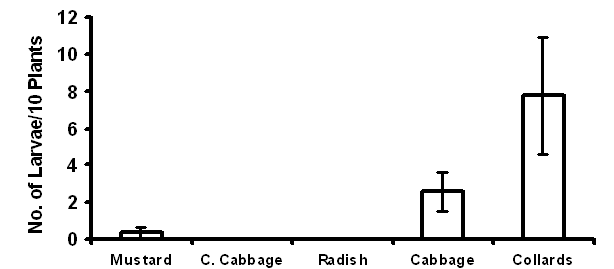
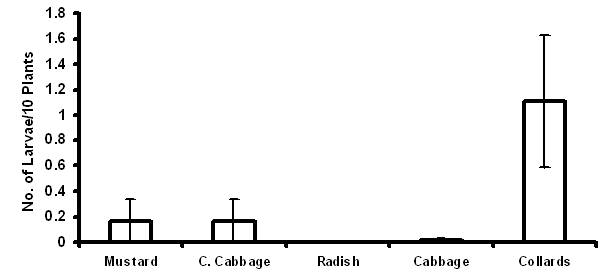
Figure 1. Incidence of P. xylostella on crucifer crops (trial 1)
Figure 2. Incidence of P. xylostella on crucifer crops (trial 2)
The collards consistently had more larvae than the cabbage in both the trials, (P= .0052, trial 1, P= .0002, trial 2). Srinivasan and Krishna Moorthy (1992) reported that Indian mustard attracted P. xylostella in the cabbage fields. Silva-Krott et al. (1995) did not find any difference in incidence of the larvae of P. xylostella in cabbage and Indian mustard plots in Guam. However, Charleston and Kfir (2000) found more egg laying, but low survival rate of the larvae on Indian mustard. In our trials, collards had more larvae than mustard (P= .0139, trial 1; P= .0001, trial 2). In Florida, Mitchell et al. (2000) also found that collards attracted more larvae in the cabbage fields. Now, trap cropping with collards in cabbage fields has become a popular practice in the United States of America. Since the P. xylostella populations in India and South Africa are attracted to the Indian mustard and the populations in Guam and the continental U.S.A are attracted to collards, it is possible that the populations in India (South Asia) and South Africa (Africa) may be different from the ones in the Pacific and the U.S.A.
Larval counts of H. undalis in the two trials are shown in Figures 3 and 4. Mustard (p = .0001) and radish (p = .0001) had more larvae in the first trial and, in the second trial, mustard (p = .0232) had more larvae than cabbage. Even though there were more larvae on Chinese cabbage and radish than on cabbage, the difference was not statistically significant. These results conform with previous reports of Muniappan and Marutani (1992), Silva-Krott et al. (1995) and Muniappan et al. (1997).
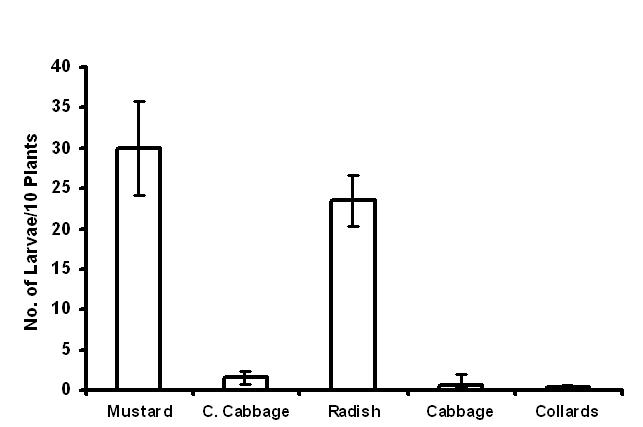
Figure 3. Incidence of Hellula undalis on crucifer crops (trial 1)
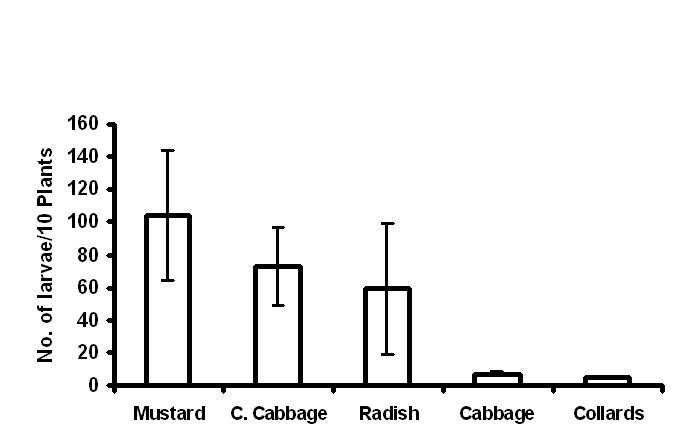
Figure 4. Incidence of Hellula undalis on crucifer crops (trial 2)
There were more larvae of S. litura on collards than on Chinese cabbage (p = .0275), radish (p = .0077) and mustard (p = .0147), but numbers were not significantly different from those on cabbage in trial 1. In the second trial there were more larvae on cabbage than on other crops (p = .0001) (Figures 5 and 6). These results also conform with previous reports. The thick and leathery leaved crucifers like cabbage and collards seem to attract more S. litura than the thin leaved radish, mustard and Chinese cabbage. We are yet to find a trap crop for S. litura in cabbage fields.
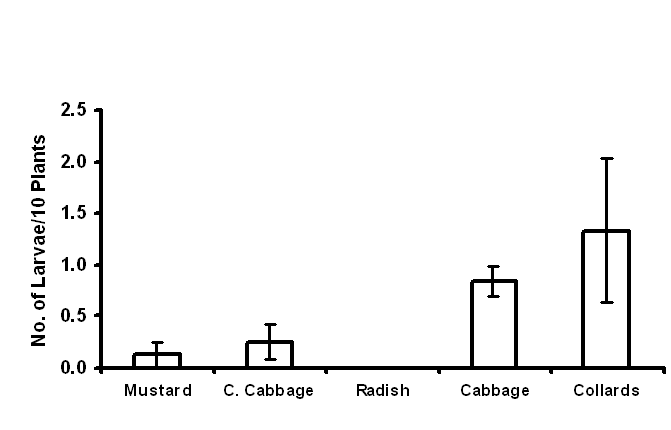
Figure 5. Incidence of Spodoptera litura on crucifer crops (trial 1)
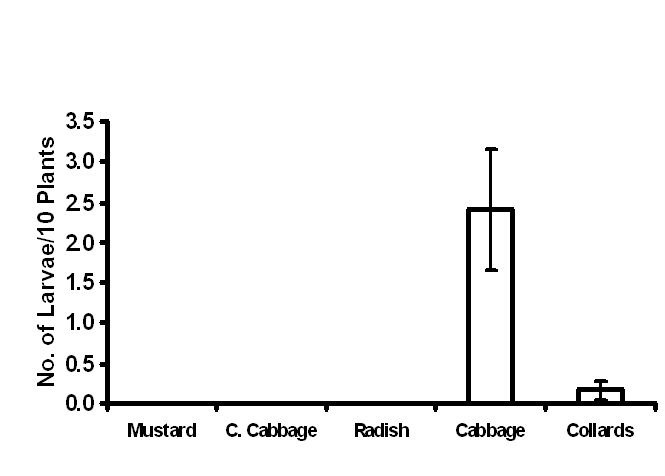
Figure 6. Incidence of Spodoptera litura on crucifer crops (trial 2)
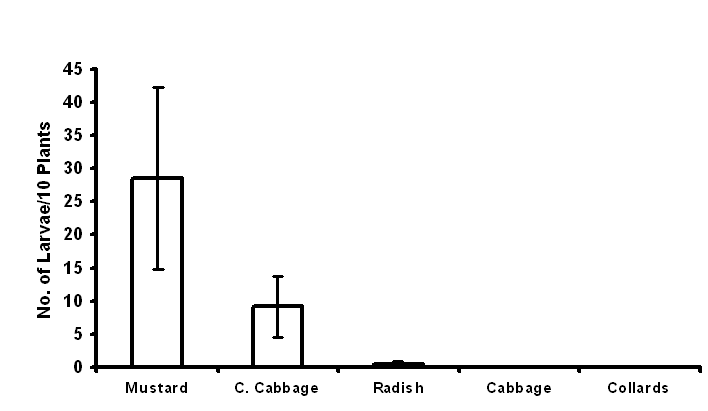
Figure 7. Incidence of Crocidolomia pavonana on crucifer crops (trial 1)
The incidence of C. pavonana populations in both the trials was low. Only in the first trial were we able to analyse the data. It was found that mustard attracted significantly more larvae than did other crops tested (Figure 7). There was more H. tibialis in Chinese cabbage and radish in trial 1 (Figure 8).
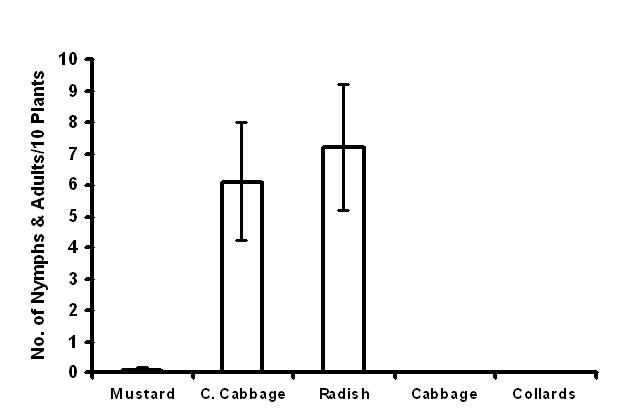
Figure 8. Incidence of Halticus tibialis on crucifer crops (trial 1)
Growing Chinese cabbage, radish, mustard and collards as trap crops in cabbage fields could effectively reduce the incidence of P. xylostella, H. undalis, C. pavonana and H. tibialis. In earlier trials, mustard was also found to attract aphids. This method could be incorporated in integrated pest management programs as it reduces pesticide use, harbours natural enemies thus enhancing biological control and is amenable for other methods of control without interference.
Acknowledgements
Funding for this work was provided by the grant 93–34135–8827 of the Pacific Basin Administrative Group, Tropical and Subtropical Agriculture Research, Cooperative State Research, Education and Extension Service, U.S. Department of Agriculture and the Guam Agricultural Experiment Station. Thanks are to Dr. Russell Campbell for reviewing this manuscript.
References
Buechi R. 1990. Investigations on the use of turnip rape as trap plant to control oilseed rape pests. International Organization for Biological Control, West Palaearctic Regional Section Bulletin 13 (4): 32–39.
Charleston DS & Kfir R. 2000. The possibility of using Indian mustard, Brassica juncea as a trap crop for the diamondback moth, Plutella xylostella, in South Africa. Crop Protection 19, 455–460.
Hokkanen HMT. 1989. Biological and agrotechnological control of the rape blossom beetle, Meligethes aeneus (Coleoptera, Nitidulidae). Acta Entomologica Fennica 53, 25–29.
Hokkanen HMT. 1991. Trap cropping in Pest Management. Annual Review of Entomology 36, 119–138.
Hokkanen H, Granlund H, Husburg GB & Markkula M. 1986. Trap crop used successfully to control Meligethes aeneus (Col., Nitidulidae), the rape blossom beetle. Annales Entomologici Fennici 52, 115–120.
Mitchell ER, Hu G & Johanowicz D. 2000. Management of diamondback moth (Lepidoptera: Plutellidae) in cabbage using collard as a trap crop. HortScience 35, 875–879.
Muniappan R, Lali TS & Singh P. 1997. Trap crop for some cabbage pests of the Asia Pacific lowland tropics. In: The management of diamondback moth and other crucifer pests (eds A Sivapragasam, WH Loke, AK Hussan & GS Lim). Proceedings of the Third International Workshop, 29 October - 1 November 1996, Kuala Lumpur, Malaysia, Malaysian Agricultural Research and Development Institute (MARDI), pp. 139–142.
Muniappan R & Marutani M. 1992. Management for head cabbage production on Guam. In: Diamondback moth and other crucifer pests (ed NS Talekar). Proceedings of the Second International Workshop, Tainan, Taiwan, 10-14 December 1990, Asian Vegetable Research and Development Center, Shanhua, Taiwan, AVRDC Publication No. 92-368, pp. 541–549.
Silva-Krott IU, SinghP, Lali TS & Muniappan R. 1995. Development of a trap cropping system for cabbage in Guam. Pest Management in Horticultural Ecosystems 1, 28–35.
Srinivasan K & Krishna Moorthy PN. 1991. Indian mustard as a trap crop for management of major lepidopterous pests on cabbage. Tropical Pest Management 37, 26–32.
Srinivasan K & Krishna Moorthy PN. 1992. Development and addition of integrated pest management for major pests of cabbage using Indian mustard as a trap crop. In: Diamondback moth and other crucifer pests (ed NS Talekar). Proceedings of the Second International Workshop, Tainan, Taiwan, 10-14 December 1990, Asian Vegetable Research and Development Center, Shanhua, Taiwan, AVRDC Publication No. 92-368, pp. 511–521.
Smyth RR. 1999. Effect of host plant phenology on oviposition preference for Crocidolomia pavonana (Fabricius) (Lepidoptera: Pyralidae): Implications for trap cropping in cabbage. M.Sc. Thesis, Cornell University, pp. 109.
SYSTAT. 1992. SYSTAT for Windows, Version 5. SYSTAT, Inc., Evanston, Illinois.
Young F. 1988. Soil Survey of Territory of Guam, USDA, Soil Conservation Service. pp. 166.





